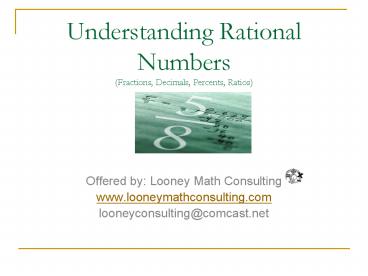Understanding Rational Numbers (Fractions, Decimals, Percents, Ratios) - PowerPoint PPT Presentation
1 / 12
Title:
Understanding Rational Numbers (Fractions, Decimals, Percents, Ratios)
Description:
Understanding Rational Numbers (Fractions, Decimals, Percents, Ratios) Offered by: Looney Math Consulting www.looneymathconsulting.com looneyconsulting_at_comcast.net – PowerPoint PPT presentation
Number of Views:385
Avg rating:3.0/5.0
Title: Understanding Rational Numbers (Fractions, Decimals, Percents, Ratios)
1
Understanding Rational Numbers(Fractions,
Decimals, Percents, Ratios)
- Offered by Looney Math Consulting
- www.looneymathconsulting.com
- looneyconsulting_at_comcast.net
2
What will educators learn from the course
Understanding Rational Numbers?
- Educators (both regular and special ed) will
- enhance their own mathematics knowledge in the
area of rational numbers fractions, decimals,
percents and ratios. - better understand why children struggle
understanding rational number concepts and will
learn how to move children forward. - create and interpret assessment tasks for common
misconceptions and implement targeted
intervention plans. - learn how to integrate the use of technology in
their classrooms. - gain comfort with wide-range of strategies and
tools for teaching concepts including the use of
visual models and manipulatives .
3
Connecting Content and Pedagogy
- Content
- Definition of rational numbers
- Representations of fractions and decimal numbers
- Comparison of fractions and decimal numbers
- Operations with fractions and decimal numbers
- Rates, ratio and proportions
- Probability and Odds
- Pedagogy
- Use of models
- Real World Applications
- Development of concept and meaning
- Development of Learning Communities
- Assessments for Common Misconceptions
- Intervention plans
4
What is the grade span for this course?
- Kindergarten through Grade 8
- Teachers who teach rational number concepts
(Grades 3 8) - Teachers wishing to enhance their own
understanding of rational number concepts and to
make connections to foundational concepts taught
in early grades - (Grades K 2)
- Special educators, coaches, administrators
5
Details
- Staff Taught by highly qualified teams of 3
- Hours 40 hours face-to-face instruction / 20
hours on-line (5 face-to-face days) - PDPs 67.5 for course completion / 90 if taken
for graduate credit - Graduate Credits 4 available through Endicott
College for 240
6
A Day in Understanding Rational Numbers .
- Participants move between all of the following
throughout each day of the course - Whole group instruction, small group, partners
- Hands-on use of manipulatives
- Games with a purpose
- Reading and discussing research articles and case
studies - Analyzing student work
- Creating lessons and assessments
- Using technology
7
Sample Activity
- Creating Concept Maps
8
Constructing Deep Understanding and Visual Models
How is division by one-half different than
division by 2? Discuss the relationship
of 2 and x ½.
9
On-line Component
- Participants required to obtain MassONE ID from
district technology coordinator prior to the
start of class - Use of technology integrated throughout the
course in a supportive environment - On-line Assignments include
- Readings
- Web-based activities
- Discussion forums
10
Sample On-line Session
- Models for FractionsIn this session, you will
look at various models for representing
fractions. Please complete the following
assignments - 1. Visit the website PBS - the Fractionator and
the Decimal Activities website. - 2. Read the article Creating, Naming and
Justifying Fractions and Teaching Fractions. - 3. Post to the discussion forums by Thursday
evening. Respond to one other post by Sunday
evening. - Session 2 Assignments (Word document )
- PBS - the Fractionator file (website)
- Decimal Activities file (website)
- Creating, Naming and Justifying Fractions (PDF
document ) - Teaching Fractions (PDF document)
- Models for Understanding Fractions (Discussion
Forum )
11
Resources to share back with district
- Workshop
- Reference List
- Alignment to textbook and standards
- Assessments
- Common Misconceptions / student work
- Technology
12
Questions?
- Please contact
- Dr. Susan Looney
- Looney Math Consulting
- looneyconsulting_at_comcast.net































